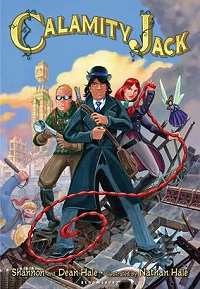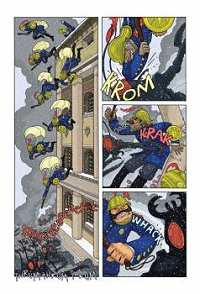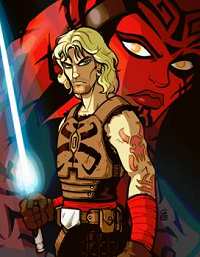 |
|
Miracle Pictographs
|
July 2010
May The Fork Bewitch You.
Calamity Jack (Bloomsbury 2010), Star Wars: Legacy vols. 1-3: Broken, Shards, Claws of the Dragon (Dark Horse 2007-2008)
Last year, a comic stole my heart. It was called Rapunzel's Revenge, a bad-mother-shut-yo-mouth update of the fairy tale with the addition of the Old West and a
braid-whipping bronco-riding Rapunzel.
It sounds silly. I know. But writer Shannon Hale pulled off the same gutsy heroine,
character growth and thrill-a-minute action that she did in The Goose Girl and her
other books, aided this time by her husband Dean Hale and artist Nathan Hale.
Rapunzel, in a quest to free her real mother and a host of slaves from the evil
Mother Gothel, became just the kind of gutsy, funny, uncompromising heroine that
graphic fiction needs.
(Ironically enough, Shannon Hale's books currently sport an enormous cover quote
from Stephanie Meyer. I wish Meyer had taken lessons from Hale on how to write
a proactive female protagonist.)
Rapunzel was helped in her adventures by one Jack of a certain beanstalk. If
Rapunzel's Revenge stole my heart, Calamity Jack, the sequel, stole my lungs and
liver and anything else that was left, since the hero, Rapunzel's paramour, is a
scoundrel with a heart of gold in the great Han Solo tradition.

Calamity Jack tells things from inside Jack's head, as opposed to Rapunzel's.
Previous to Revenge, Jack grew up a thieving rapscallion on the streets of Shyport,
the cosmopolitan fairy-tale East to the Old West of the first book.
Jack was constantly thieving and scheming until he sought to rid his poor mother
of her evil giant landlord. Things went awry in a scheme involving a few magic
beans and the resulting beanstalk. Jack made off with a golden-egg-laying goose,
killed a giant, and got himself a death warrant from the corrupt giant politicians.
On the run, Jack met Rapunzel, and in his words, "things got complicated." The
story picks up after the events of Revenge as he prepares to come home to Mama,
giants be damned.
After a breathtaking adventure on a moving train (of course!), they return to a city
that has nearly become a police state. Blunderboar, the giant boss who put the
warrant on Jack's head, has taken over the police force and is locked in a war with
the giant ants swarming out of the sewers to take over the city. Of course, when
one looks closely, it appears that things are not so antagonistic between the giants
and the ants--it looks more as though their battles exist merely to smash up
businesses that compete with Blunderboar's empire.
Jack, upon discovering that his mother's debt to Blunderboar has grown worse,
determines to put the horrific giant out of business, starting with an investigation
into the ants. And thus the adventure goes, as Rapunzel and Jack investigate
Blunderboar's secrets, team up with a hat-loving pixie, dodge the teeth of a
Jabberwocky and the poisonous spit of a Bandersnatch, and meet a handsome
inventor who, despite what appears to be a case of Asperger's syndrome married
with Superman's vocabulary, presents himself as a competitor for Jack's affection
for Rapunzel.
Jack spends a good amount of the book trying not to let Rapunzel know that he
was once a dirty thief, afraid that her wholesome heart will reject him if she finds
out. It makes for an awkward situation, since he is also determined to impress her
with his decisiveness. In one section, Freddie, the requisite other man, buys
Rapunzel a cake and shyly proclaims, "It is because you are, ah, sweet like cake."
Rapunzel looks over at Jack. "Jack, do you think I'm sweet like cake?"
"Not on your life," Jack answers. A moment later his internal monologue rambles
on, 'because she's not some fancy city girl; she's tough and gutsy and full of
pluck,' but by this point, Rapunzel has already sauntered over to Freddie, punched
him in the arm and angrily declared, "I love cake!'
This kind of thing is par for the course in a story about plucky young heroes in
love, but it started to annoy me after a while. How oblivious could Jack and
Rapunzel be? They already shared a kiss in Rapunzel's Revenge. They have to
have some kind of communication skills in their relationship by now.
Or maybe not. Perhaps I'm forgetting how awkward it is to be young and in love
and having adventures with giants and ant people.
Nathan Hale's art is a beautiful mix of whimsy and animated energy. Giants are
immense blocky figures with jutting jaws that could swallow a human whole.
Cavernous sewers hold armies of man-sized ants and mutant pigeons. A zeppelin
fight at the end has our heroes leaping airborne masts and rope ladders, and sent
my acrophobic stomach into knots.

I had one of those brilliant and painful moments upon reaching the end of this
comic. I hated finishing it. I hated it because I was totally conscious that I could
never again read Calamity Jack for the first time, no matter how much I might
enjoy it on the second, third and twentieth time. So I shouted at the torrential sky,
"WHY CAN'T ALL COMICS BE THIS GOOD?" and then sank into a puddle,
sobbing. "Why, God. Why?"
Ahem.
I only do that with really good comics, by the way, and never in public places.
Definitely. Moving on…
I'm not much of a Star Wars fan. I was. I can remember the precise moment it all
fell apart.
It wasn't the first time Jar Jar Binks opened his mouth, or the first time little
Anakin said "Wizard!" It was that moment where Qui-Gon and Anakin were
standing on a launching pad and little Anakin asked, "What are midichlorians?"
The term "midichlorians" had been tossed around earlier in the movie, but I had
written it off as a simple little tech reading used to indicate that Anakin was
special. We really didn't need to know what midichlorians are. They were merely
that most precious of fictional substances, handwavium, that which lends itself to
science fiction's technological wizardry.
But instead of accepting that principle, Lucas wrote an exchange where Qui-Gon
kneels down and tells Anakin what midichlorians are, so that little Anakin could
nod his head and never mention these tiny organisms again… and I realized, "By
the Force… George Lucas has no idea why these movies work!"
Nobody wants a biological basis for the Force. It's the same reason why we don't
care that Han Solo misused the term "parsec." Star Wars is an archetypal story that
needs to stick very close to its archetypes and avoid too many details. Lucas's
prequels had all the requisite dogfights, lightsaber fights, and C-3P0 strutting
around fussing. But they substituted this kind of silly internal "consistency" and
talkiness for emotion. George Lucas was finally able to shoot on enormous green
screens and computer-animate his actors into doing what he wanted. He forgot that
there was a story there.
It was a really good story too, had he paid attention. Anakin learns too fast and lets
his own hotheadedness drive him, so that when he becomes an adult, Anakin's own
fears, those he ran away from, eat him alive. How can you go wrong with that?
Anakin could have been Achilles, a warrior too prideful too see his own downfall
coming. He could have been Othello, consumed by an irrational fear. He could
have been MacBeth, a man subsumed his morality into what he believed what his
destiny. Instead, he was a whinging teenager. "Obi-Wan never lets me do
anything!"
Today my hopechlorian reading for Star Wars is okay. Because Cade Skywalker,
hero of Legacy, might just be the character Anakin should have been.

Star Wars: Legacy is set one hundred years and change after the events of Return
of the Jedi. Cade, great-grandson of Luke, escapes with a group of Jedi just ahead
of an invasion of Sith and reborn Imperial forces, but he is forced to leave his
father behind. Defying his teacher's orders, he hops in a ship and heads back to the
surface of the planet to try and save his father.
Promptly feeling his father's death in the Force, Cade, in the hotheaded Skywalker
tradition, decides to take vengeance on the Sith scum who killed his father. His
ship is shot out of the sky.
Twenty years later, the galaxy is still in turmoil--poor galaxy can't catch a
break--as the Sith have staged a coup against their former ally Emperor Roan Fel.
Fel has escaped with his Imperial Knights, a kind of paramilitary Jedi and a third
faction in the Jedi/Sith conflict. The Jedi are in hiding and the remnants of the
Galactic Alliance frantically fight both the Imperial forces loyal to Fel and the Sith.
The ruling Sith, Darth Krayt, has sent an evil and sexy lady Sith after Marasiah Fel,
daughter of the rightful emperor-in-hiding. Marasiah has escaped to one of those
wretched hives of scum and villainy that are never far away in the Star Wars
universe, where she meets a shiftless, amoral bounty hunter named… Cade.
Cade recognizes her and fully tries to sell her back to the Sith at the highest bidder.
But when he is actually confronted with the Sith who killed his father, his outlook
changes and he reveals his long dormant Force powers, both by tossing around a
lightsaber and healing Marasiah of a mortal wound.
At this point… well, it's not in prequel territory, but the story has squandered a lot
of its promise. When we first meet him, Cade is a great character in the Joseph
Campbell tradition. He is the hero who has rejected the call and continues to try
and run from it.
But writer John Ostrander doesn't know how to pare down his cast. Cade has two
sidekicks, an alluring lady and another seedy pirate. Why couldn't they be
combined? Marasiah Fel also has a sidekick and several Imperial Knights trying to
find her. In the concluding scenes of Broken, two Jedi, Marasiah and her sidekick,
the Imperial Knights and Cade and his sidekicks all fight the Sith. I needed a
scorecard.
The story could have been about the relationship between Cade and Marasiah,
whom Cade Force-heals with the innate power he hasn't used in years. They are
both heirs to a troubled legacy and on the run from forces that would destroy them
for that legacy and not for any sins of their own.
Instead, Cade and Marasiah's relationship gets lip service with a brief
conversation. Cade's romantic subplot is restricted to the throwaway character
Deliah Blue, a mechanic sidekick who seems to exist merely to strut around in
teeny outfits and give naught looks to Cade.
Jan Duursema is an artist with her ups and downs, but the crowded scenery and
casts tend to detract from her art. She gets expressions and she draws beautiful
figures. Especially impressive is the way that Cade really resembles Mark Hamill
and Hadyn Christiansen. But her action sequences are utterly confusing. I'm never
sure what exactly the Jedi are doing with their lightsabers, or where the space
fighters are going.
That's no good in a comic that requires as much action as Star Wars. It becomes
downright frustrating after a while, especially since I have seen so many good
artists on various Star Wars projects.
Legacy isn't a bad read, and it sure will wash the taste of prequel out of your
mouth. It's just not as good as it could have been. I wish John Jackson Miller,
author of the Knights of the Old Republic series, had taken the writing reins here.
This story, liberated as it is from the Star Wars move period so ruled by Lucas,
could really fly free.
I comfort myself by thinking that there is a kid, possibly in film school at the
moment, who will remake those movies one day, perhaps taking Cade as his cue
for what Anakin should have been.
May the Force be with us, and may Han always shoot first.
Read more by Spencer Ellsworth